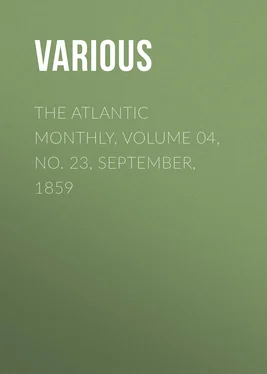Various - The Atlantic Monthly, Volume 04, No. 23, September, 1859
Здесь есть возможность читать онлайн «Various - The Atlantic Monthly, Volume 04, No. 23, September, 1859» — ознакомительный отрывок электронной книги совершенно бесплатно, а после прочтения отрывка купить полную версию. В некоторых случаях можно слушать аудио, скачать через торрент в формате fb2 и присутствует краткое содержание. Жанр: foreign_antique, periodic, foreign_edu, на английском языке. Описание произведения, (предисловие) а так же отзывы посетителей доступны на портале библиотеки ЛибКат.
- Название:The Atlantic Monthly, Volume 04, No. 23, September, 1859
- Автор:
- Жанр:
- Год:неизвестен
- ISBN:нет данных
- Рейтинг книги:4 / 5. Голосов: 1
-
Избранное:Добавить в избранное
- Отзывы:
-
Ваша оценка:
- 80
- 1
- 2
- 3
- 4
- 5
The Atlantic Monthly, Volume 04, No. 23, September, 1859: краткое содержание, описание и аннотация
Предлагаем к чтению аннотацию, описание, краткое содержание или предисловие (зависит от того, что написал сам автор книги «The Atlantic Monthly, Volume 04, No. 23, September, 1859»). Если вы не нашли необходимую информацию о книге — напишите в комментариях, мы постараемся отыскать её.
The Atlantic Monthly, Volume 04, No. 23, September, 1859 — читать онлайн ознакомительный отрывок
Ниже представлен текст книги, разбитый по страницам. Система сохранения места последней прочитанной страницы, позволяет с удобством читать онлайн бесплатно книгу «The Atlantic Monthly, Volume 04, No. 23, September, 1859», без необходимости каждый раз заново искать на чём Вы остановились. Поставьте закладку, и сможете в любой момент перейти на страницу, на которой закончили чтение.
Интервал:
Закладка:
"There are also treasures of disappointed pleasure and of bitterness in this picture of 'The Lamentations of Earth to Heaven,'—dim symbol of human suffering. How does one, in the presence of this poem, feel filled with the spirit of St. Augustine, the nothingness of what we call joy, happiness, glory, here below,—delights of a moment, which at most only aid us to traverse in a dream this valley of tears! Certain pages of 'The City of God,' funeral prayers of Bossuet, can alone serve us for a comparison, in order to express the effect produced upon those who have visited this chef d'oeuvre in Ary Scheffer's atelier . Before producing it, the artist must have thought long, suffered long; for each stroke of the pencil seems to hide a grief, each figure speaks to you in passing, and utters a complaint, a sigh, a prayer,—sad echoes of the despair of life! The religious tendency of the thinker is here fully shown; his poetic sympathy, his aspirations, his dreams, have found a free course. We must mark, also, with what freedom his lamentations spring from the ground, to carry even to the feet of the Creator the overwhelming weight of earthly woe. Ary Scheffer's picture is like the epitaph destined some day for the obsequies of the world; it breathes of death, and has the sombre harmony of the Miserere. And nevertheless,—a strange thing!—this dreaming painter, who seizes and afflicts us, is the same man who at the same time reassures and consoles us,—without doubt, because by dint of spiritualizing our thoughts he raises them above our sufferings, by showing the consoling light of eternity to those whom he would sever from the deceitful joys of earth."
If the picture be not overcolored by the critic's eye, we must believe this to be the culmination of the morbidly spiritualistic tendency which we meet in Scheffer's works. Yet it never exists unrelieved by redeeming qualities. Many will remember the original picture of the "Dead Christ," which was exhibited here by an Art Union about ten years ago. The engraving gives but a faint idea of the touching expression of the whole group. The deathly pallor of the corpse was in strange harmony with the face of the mother which bent over it, her whole being dissolved in grief and love. No picture of this scene recalls to us more fully the simple account in the Gospels. The cold, wan color of the whole scene seems like that gray pall which a public grief will draw across the sky, even when the meridian sun is shining in its glory. We have seen such days even in Boston. No wonder that darkness covered the land to the believing disciples even until the ninth hour.
His "St. Monica," which appeared in 1846, met with great success. "Ruth and Naomi" is yet unknown to us, but it seems to be a subject specially adapted to his powers. Of those works which he produced within the last twelve years, very few are yet engraved. When thus placed before the public, we believe the popular estimate of Scheffer will be raised even higher than at present.
His pictures of Christ are of very superior merit. His representation of the person of Jesus was not formal and conventional, but fresh in expression and feeling, and full of touching pathos and sentiment. He has neither the youthful beauty with which the Italians represent him, nor the worn and wasted features which the early Germans often gave him, but a thoughtful, earnest, tender beauty. The predominant expression is the love and tenderness born of suffering. Three of his finest representations of the life of Jesus of Nazareth are, "The Christ weeping over Jerusalem," the "Ecce Homo," and "The Temptation." The last is as original in design and composition; it is noble in expression. The two figures stand on the summit of a mountain, and the calm, still air around them gives a wonderful sense of height and solitude. You almost feel the frost of the high, rare atmosphere. Satan is a very powerful figure,—not the vulgar devil, but the determined will, the unsanctified power. The figure of Christ is simple and expressive,—even the flow of the drapery being full of significance and beauty. Another composition of great beauty represents a group of souls rising from earth, and soaring upwards to heaven. The highest ones are already rejoicing in the heavenly light, while those below seem scarcely awakened from the sleep of death. The whole picture is full of aspiration; everything seems mounting upwards.
Scheffer also painted a few pictures which can hardly be called his own. Such are "The Battle of Tolbiac," and "Charlemagne dictating his Statutes." These were painted by the command of Louis Philippe, who was his constant friend and patron. The young princes were his pupils; and Scheffer was careful to form them to better taste than that of the citizen monarch who has lined Versailles with poor pictures. For the King he painted "The Battle of Tolbiac," and we can only regret the time which was thus wasted; but for his pupils he designed "Francesca da Rimini" and the "Mignons."
A few masterly portraits by Scheffer's hand indicate his power of reproducing individual character. Among these we may name that of his mother, which is said to be his finest work,—one of the Queen,—a picture of Lamennais,—and another of Emilia Manin, to which we shall again refer. He occasionally modelled a bust, and sometimes engaged in literary labor, contributing some valuable articles on Art to "La Revue Française."
It would be impossible for us to analyze or even enumerate all of Scheffer's works. They are scattered throughout France and Holland, and a few have found their way to this country. Most of the engravings from his pictures are too well known to require description; and we feel that we have said enough to justify our placing Scheffer in the high rank which we claim for him. Engravings give us a juster idea of the French than of the Dutch or Italian artists; for their merit is rather in design and composition than in color. We agree with M. Vitet, that color need not be a prominent excellence in a work of high spiritual beauty, and that it should always be toned to a complete harmony with the prevailing feeling of the picture. In this aspect we look upon the cold color of the "Dead Christ" as hardly a defect; it is in keeping with the sad solemnity of the scene. But if color should not be so brilliant as to overpower the expression of form and sentiment, still less should it be so inharmonious as to distract the mind from it, as is sometimes the case with Scheffer. The "Dante and Beatrice" is a familiar instance. We can see no reason why Beatrice should be dressed in disagreeable pink, and Dante in brick-red. Surely, such color is neither agreeable to the eye nor harmonious with the expression of the scene. This defect in color has led many to prefer the engravings to Scheffer's original pictures; but no copy can quite reproduce the nice touches of thought and feeling given by the master's hand. Color is supposed by many to belong mainly to the representation of physical beauty; but has not Allston proved to us that the most subtile and delicate harmonies of color may be united with ethereal grace and spiritual beauty? Compare his "Beatrice" with that of Scheffer. But, in truth, the whole spiritual relation of color is yet but dimly understood; and there are, perhaps, influences in the climate and organization of the French nation which have rendered them inferior in this department of Art. Allowing this deduction—a great one, certainly,—still, if the expression of the highest thoughts in the most beautiful forms be the true aim of Art, Scheffer must rank among the very first painters of his age. Delaroche may surpass him in strength and vigor of conception, and in thorough modelling and execution; but Scheffer has taken a deeper hold of the feelings, and has risen into a higher spiritual region.
It has been reproachfully said that Scheffer is the painter for pretty women, for poets, and for lovers. The reproach is also a eulogium, since he must thus meet the demand of the human soul in its highest and finest development. Others have accused him of morbid sensibility. There is reason for the charge. He has not the full, round, healthy, development which belongs to the perfect type of Art. Compare the "St. Cecilia" of Scheffer—this single figure, with such womanly depth of feeling, such lofty inspiration, yet so sad—with the joyous and almost girlish grace of Raphael's representation of the same subject, and we feel at once the height and the limitation of Scheffer's genius. There is always pathos, always suffering; we cannot recall a single subject, unless it be the group of rising spirits, in which struggle and sorrow do not form the key-note.
Читать дальшеИнтервал:
Закладка:
Похожие книги на «The Atlantic Monthly, Volume 04, No. 23, September, 1859»
Представляем Вашему вниманию похожие книги на «The Atlantic Monthly, Volume 04, No. 23, September, 1859» списком для выбора. Мы отобрали схожую по названию и смыслу литературу в надежде предоставить читателям больше вариантов отыскать новые, интересные, ещё непрочитанные произведения.
Обсуждение, отзывы о книге «The Atlantic Monthly, Volume 04, No. 23, September, 1859» и просто собственные мнения читателей. Оставьте ваши комментарии, напишите, что Вы думаете о произведении, его смысле или главных героях. Укажите что конкретно понравилось, а что нет, и почему Вы так считаете.












